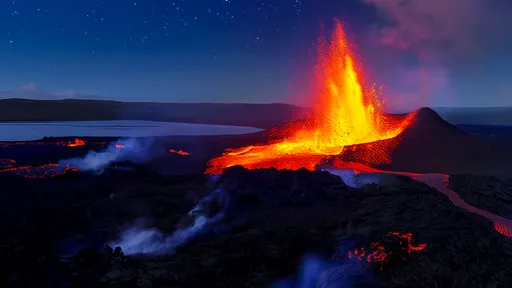The Earth's crust occasionally reveals its fiery temperament through volcanic eruptions, events that can reshape landscapes and alter climates in mere moments. While these geological phenomena inspire awe, they also pose significant threats to nearby communities. Understanding the warning signs of an impending eruption has become a critical focus for volcanologists worldwide, as early detection can mean the difference between life and death.
Volcanoes seldom erupt without warning. Like a simmering pot about to boil over, they exhibit subtle yet detectable changes in behavior before releasing their pent-up energy. Modern monitoring techniques have advanced significantly, allowing scientists to interpret these signals with increasing accuracy. From ground deformation to gas emissions, each clue offers a piece of the puzzle in predicting when a volcano might transition from slumber to fury.
Ground movements often provide the first visible indications of magma migration beneath a volcano's surface. As molten rock forces its way upward, it causes the surrounding earth to bulge and shift. This deformation can be measured using sophisticated tools like tiltmeters, GPS stations, and satellite-based radar systems. In some cases, the swelling is dramatic enough to be observed with the naked eye, as witnessed during the 1980 buildup to Mount St. Helens' catastrophic eruption.
Earthquake activity serves as another crucial warning sign. The fracturing of rock as magma pushes through creates distinctive seismic patterns known as harmonic tremors. These differ from typical tectonic earthquakes in their frequency and duration, providing volcanologists with valuable information about magma movement. The increasing frequency and intensity of these quakes often correlate with imminent eruption potential, though interpreting their precise meaning remains as much art as science.
Changes in volcanic gas emissions offer additional insights into subsurface activity. As magma rises, the decreasing pressure allows dissolved gases like sulfur dioxide and carbon dioxide to escape. Scientists measure these emissions using ground-based sensors and airborne instruments, with sudden increases often signaling fresh magma approaching the surface. The composition of these gases also changes as eruption nears, with certain ratios indicating different stages of magma ascent.
Thermal monitoring has become increasingly important in eruption prediction. Infrared satellite imagery and ground-based thermal cameras can detect subtle temperature changes around volcanic vents and flanks. These heat anomalies may indicate new magma nearing the surface or changes in hydrothermal systems. Some volcanoes exhibit predictable thermal patterns before eruption, though each volcanic system possesses unique characteristics that require careful study.
Hydrothermal systems surrounding volcanoes often show noticeable changes prior to eruptions. The heating or acidification of groundwater can alter hot spring temperatures and chemistry, while some volcanoes display increased geyser activity. These changes reflect the complex interactions between rising magma and underground water systems, providing yet another set of clues for observant scientists.
Animal behavior has occasionally provided anecdotal warning signs before major eruptions. While not scientifically quantifiable, numerous accounts describe wildlife fleeing volcanic areas days before catastrophic events. From the famous case of animals abandoning the area before the 1902 Mount Pelée eruption to more recent observations in Indonesia, these biological indicators continue to intrigue researchers studying eruption precursors.
The challenge in volcanic prediction lies not just in detecting these signals, but in interpreting their significance. Some volcanoes exhibit all these warning signs for months without erupting, while others transition from quiet to explosive with frightening speed. This variability stems from differences in magma chemistry, tectonic setting, and volcanic structure, making each volcano a unique puzzle requiring individualized monitoring approaches.
Modern monitoring networks combine multiple detection methods to create comprehensive hazard assessments. These systems integrate real-time data from seismic sensors, gas analyzers, deformation measurements, and thermal cameras, feeding information to observatories where experts analyze the patterns. The development of machine learning algorithms has enhanced this process, helping identify subtle correlations that might escape human notice.
Public communication of volcanic threats remains as crucial as the scientific monitoring itself. Even the most accurate predictions serve little purpose if nearby populations don't receive timely, understandable warnings. Volcanic alert level systems have been standardized in many countries, providing clear guidelines for emergency response based on the severity of observed precursors.
Historical records and geological studies contribute significantly to eruption forecasting. By examining a volcano's past behavior, scientists can identify patterns and recurrence intervals. Some volcanoes erupt with remarkable regularity, while others have dormancy periods spanning centuries. Understanding this eruptive history helps contextualize current monitoring data and improves long-term hazard assessments.
Despite technological advances, volcanic prediction still carries substantial uncertainty. The 1980 Mount St. Helens eruption was preceded by clear warnings, while the 2014 Ontake eruption in Japan occurred with virtually no precursory signals. This unpredictability underscores the need for continued research and improved monitoring techniques, particularly in densely populated volcanic regions.
International collaboration has strengthened global volcanic monitoring efforts. Organizations like the International Association of Volcanology and Chemistry of the Earth's Interior facilitate data sharing and standardized practices across borders. This cooperation proves especially valuable for volcanoes near national boundaries or in developing nations with limited monitoring resources.
As climate change alters atmospheric conditions, researchers are investigating potential impacts on volcanic activity. Some studies suggest that melting glaciers could relieve pressure on certain volcanic systems, potentially increasing eruption frequency. These complex interactions between climate and volcanism represent an emerging frontier in geological research with significant implications for hazard prediction.
The economic and ethical dimensions of eruption prediction present ongoing challenges. False alarms carry substantial costs, while missed warnings can prove catastrophic. Scientists must balance the imperative to protect lives with the understanding that volcanic systems often provide ambiguous signals. This tension underscores the importance of clear communication about uncertainty in volcanic forecasting.
Looking ahead, emerging technologies promise to revolutionize volcanic monitoring. Autonomous drones capable of sampling dangerous plumes, advanced satellite constellations with improved temporal resolution, and next-generation seismic arrays all offer hope for more accurate predictions. Coupled with improved computer modeling, these tools may eventually provide reliable eruption forecasts days or weeks in advance.
The study of volcanic precursors extends beyond Earth, offering insights into planetary formation and potential life-supporting environments. By understanding how our planet releases its internal heat and chemicals, scientists gain perspective on geological processes throughout the solar system. This broader context enriches both theoretical knowledge and practical prediction methods.
Ultimately, predicting volcanic eruptions remains an imperfect science blending technology, experience, and intuition. While warning signs have become increasingly recognizable, the Earth's complex systems ensure that surprises will continue. The ongoing quest to understand these fiery phenomena reflects humanity's enduring fascination with nature's most powerful displays - and our determination to coexist safely with the planet we call home.

By /Jun 7, 2025

By /Jun 7, 2025

By /Jun 7, 2025

By /Jun 7, 2025

By /Jun 7, 2025

By /Jun 7, 2025

By /Jun 7, 2025

By /Jun 7, 2025

By /Jun 7, 2025

By /Jun 7, 2025

By /Jun 7, 2025

By /Jun 7, 2025

By /Jun 7, 2025

By /Jun 7, 2025

By /Jun 7, 2025

By /Jun 7, 2025

By /Jun 7, 2025

By /Jun 7, 2025

By /Jun 7, 2025

By /Jun 7, 2025